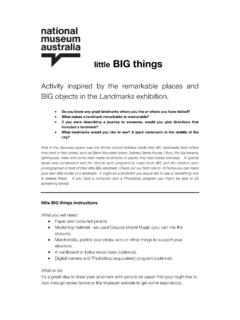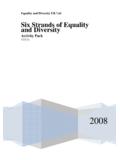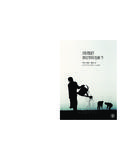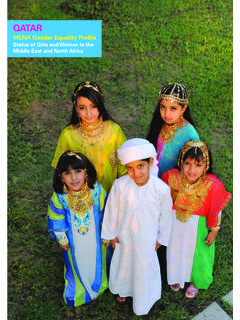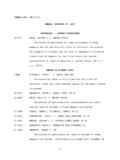Transcription of Women and equality as citizens - NMA Home
1 National Museum of Australia and Ryebuck Media 20021 How did significant movementscontribute towards Women s equalityas citizens in Australia during the twentieth century?IntroductionOne of the most important developments in Australia duringthe twentieth century was the gradual movement of womentowards full citizenship through social, economic andpolitical unit will explore a number of movements thatpromoted these changes. But first, how much do you know about Women and politics in Australia over last onehundred years? Try this quiz and then check your answersas you work through the : Women in Australian politics1 The first Women in Australia to gain the votewere those in South Australia in Women were able to vote at the first Commonwealth election in The first federal woman parliamentarian 19031919was elected in:193119434 Women currently make up what percentage of15%23%the total membership of the Federal Parliament?
2 38%43%5 The number of Women in the current federalministry (2002) is:13596 The first woman federal Cabinet Minister was 19121938appointed in:194719757 The first woman to lead a political party 19331949did so in:196319868 All Aboriginal Women gained the right to 19021924vote in:196219679 The first woman to be elected to the House Enid LyonsVida Goldsteinof Representatives was:Joan ChildNellie Powell10 The first woman to be elected to the Senate Selina SigginsAnnabelle Rankinwas:Ivy WedgwoodDorothy Tangney1 What are we commemoratingin 2002? Is it something tocelebrate?In a sense, it doesn t necessarily matter whether you knowthe specific facts in the quiz or not. The more importantpoint is whether you are aware of the origins anddevelopment of Women s contribution to the growth anddevelopment of political, economic and social change inAustralia, and the movement ofwomen towards full citizenship.
3 2002 is the centenary of femalesuffrage in Australia in 1902women were given the right to votein a Commonwealth election. Howwas that milestone achieved? Did itapply to all Women ? And have womenbeen able to influence the political,social and economic landscape inAustralia since, and if so, in whatways? As one female Commonwealthparliamentarian has said:It is the right and heritage of allAustralians to know more of thelives of the Women who went beforethem. Indeed, we cannot accuratelyknow our present if we do not knowour past.(Senator the Hon. Rosemary Crowley,Images of Women , Women andMuseums Conference Proceedings, 11-13 October 1993)yas National Museum of Australia and Ryebuck Media 20022In 1902, the Commonwealth Parliament, composed entirely ofmen, passed the Commonwealth Franchise Actwhich gave thevote to adult Women .
4 This had only previously been achievedby New Zealand (in 1893) and South Australia (in 1894, tocome into effect in 1895). Such a move was a daringpolitical and social innovation at the hundred years later, Women represent 25 per cent ofthe Commonwealth Parliament and between 12 per cent(ACT) and per cent (South Australia and Tasmania) ofstate and territory parliaments well short of theirproportion of the eligible female voting have been premiers and chief ministers but onlyin three of the eight states and territories. Women havebeen in federal cabinet but never Prime have led minor federal political parties butnever one of the three major while 2002 marks the centenary of a great politicalachievement for Women , the past one hundred years havenot necessarily led to an equal expression of full citizenshipfor Women , especially in the political life of the unit examines some of the advances Women havemade in the social, economic and political life of Australia,some of the limitations on those advances and some of thereasons for the successes and Women and equal citizenship the movement to win the voteFull citizenship in a society involves three areas of rights.
5 Civil rights these are rights related to individualfreedoms, such as freedom of speech and religion,freedom of contract, the right to own property, the rightto just treatment. Political rights these include such things as theright to form and join associations, the right to standfor, and be an elector of, democratic legislatures. Social rights these include such rights as the rightto security, ensured through welfare provisions.(James Walter and Margaret MacLeod,2002. The citizens Bargain: A Documentary History of Australian Views Since 1890, UNSW Press, Sydney, )Most Women in nineteenth century Australia lacked manyof these lives of Women revolved around raising families anddomestic work. Women were only entitled to a limitededucation and property was in the name of fathers andhusbands.
6 Even Women s bodies were not their own birth control was illegal and a woman often had to besexually available to her husband whenever he was difficult even if the husband was clearly atfault and an abused wife had little legal the end of the nineteenth century many womenbegan to believe that the only way to bring about changewas to influence the law-makers. Without a vote however,how could Women do this? The answer was to win theright to vote!Curriculum Guide: Student Learning OutcomesBy the end of this article, students will be better able to achievethese learning outcomes that are common to most states andterritories Society and Environment Key Learning Area:Time, continuity Describe and explain lasting and and changechanging aspects of Australian society (History)and environments critically compare representations of people, events and issues explain the ways core values of Australian society have endured or changed over time use knowledge about the past to explain contemporary and Analyse core values of groups and 1902, Women had won a great victory they wereable to vote in the first Commonwealth elections.
7 The rightto vote in most state elections soon did they achieve this landmark victory? Look at thefollowing sources and identify the different factors thathelped Women to gain the ASome leading Women involved incampaigning forfemale suffrageEdith Cowan (1861-1932)Edith Cowan was born in Western Australia. In 1894, shebecame president of the Karrakatta Women s Club whichencouraged Women in education and public was active in improving the conditions of unmarriedmothers and their children and in setting up nurseries for thechildren of working became the first woman elected to an Australianparliament when she won the seat of West Perth in National Museum of Australia opened in March 2001 aspart of the celebrations for the Centenary of Museum employs a fresh and exciting approach toAustralian history, culture and National Museum unit of work in STUDIES asks studentsto consider the stories and concepts behind Museum themes,objects and images, and can be used with students in Societyand Environment, History, Geography and Miller (1839-1917)
8 Born in England of a radical family,Emma eloped with Jabez Silcok andeventually emigrated to Brisbane in1879. After his death in 1880, shesupported her four children by sewing,often up to 70 hours a 1890, she was involved in theformation of a Women s union,campaigning for equal pay and votesfor Women . During an 1891 RoyalCommission, she gave evidence as ashirtmaker of the exploitation ofwomen 1894-1905, she was foundationpresident of the Women s EqualFranchise Association, where shecampaigned for the female an international socialist she opposedAustralia s involvement in World War Lee (1821-1909)Mary Lee was born in Ireland, andcame to Adelaide to nurse her sick son,who subsequently worked to protect young womenand to improve their conditions byraising the age of sexual consent tosixteen.
9 She was later secretary of theWomen s Suffrage 1894, her efforts, and those of othersin the organisation, resulted in thegranting of the vote to South Australianwomen. The League had wanted womento have the right to vote, but had notpressed for the right for Women to standfor parliament. However, an amendmentto the suffrage bill to extend the right ofwomen to stand for parliament, movedin the expectation that it would makethe bill too radical and would be thrownout, was surprisingly passed andSouth Australian Women gained far morethan they had Goldstein (1869-1949)Vida Goldstein was born into aprogressive family, where education ofgirls was valued and encouraged. In herearly life, she worked for prison reformsand for anti-sweating 1900, she became secretary of theWomen s Federal Political Association,campaigning for the Women s 1903, she stood as a candidate forthe Senate, not expecting to win, but totake advantage of the platform it gaveher to try and influence people s Scott (1847-1925)Rose Scott was born in New SouthWales and was educated at home whileher brothers were sent to 1891, she became secretary of theWomanhood Suffrage League.
10 LikeMary Lee, she tried to have the age ofconsent for girls raised from 14 to 16,but without later became a leader in theWomen s Political and EducationalLeague and campaigned to change thelaws relating to inheritance.(Biographical information based on Womenwith Attitudebooklet produced by the National Museum of Australia for an exhibitionat Old Parliament House, Canberra, 1995)1 Identify and describe the range oforganisations mentioned in thesebrief you think the existence ofthese organisations helped womenachieve the right to vote? Explainyour historians have suggested that campaigning for Women s right tovote has to be seen as part of a broader movement involving a range ofsocial reforms. Do these short biographical sketches support the view thatwomen campaigned for the vote not as an end in itself but as partof a bigger campaign for the social and political advancement of Women ?
